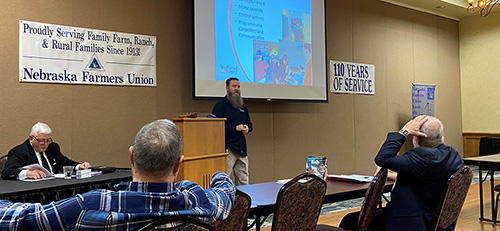NORFOLK, Neb. – On a recent, cold and windy December morning, John Liewer was asked to give a talk to the Nebraska Farmers Union on wind energy.
It was fitting weather as the Northeast Community College wind energy technology instructor had been asked to talk to conference attendees about wind-powered jobs for young people in rural communities.
As the wind howled outside of the Divots Conference Center in Norfolk – as it often does in most of Nebraska every month – it was creating energy that keeps those indoors warm. Not only is wind energy helping to keep Nebraskans comfortable year-round, but it provides lucrative career opportunities for students.
“There’s room for rapid advancement,” Liewer told those at the conference. “They can be a lead tech within a few years. The wind energy industry is growing rapidly. There are more jobs than we can provide students for.”
Wind energy is a field where students are assured employment. Those who work hard are rewarded, Liewer said.
NPPD, which supplies power to much of Nebraska, reports that 7.4% of its energy came from wind in the 2021-22 rolling two-year average. It is anticipated that it will continue to increase.
The Department of Labor indicates that wind energy jobs are the fastest growing repair and maintenance jobs out of green energy and all other industries.
“It’s all about skills. There’s a lot of aspects to wind energy, including political, but our focus is on the skills,” Liewer said.
Northeast’s wind energy program is designed to prepare students to be wind technicians and maintenance technicians. The program focuses on safety and spends about half the time on mechanical aspects. The other half is spent on electrical components.
Offerings include a one-year diploma or a two-year associate degree. The program covers a range of topics, with students arriving at all skill levels. Those who have “mechanical curiosities” do well, Liewer said. Good math skills and a technical aptitude also are benefits.
The program’s first year covers basics. Many farming and small-town students who have worked on their own vehicles and know how to turn a wrench have a big advantage, but all students can be successful, Liewer said. The first year includes everything from learning the parts and maintenance procedures to learning about electricity, including how it works, testing it and controlling it.
The second year gets more in depth, including gear boxes, gear ratios, bearings, generator alignment, hydraulics and higher-level skills.
“We integrate safety in every aspect of the program. Obviously, any job that you do -- 250 to 300 feet in the air -- is going to be dangerous,” Liewer said. “The big (concern) is falling. We do such a good job within the industry that I don’t know of anyone or know anyone who knows of someone who has fallen. You rarely hear about it.”
Another concern is dropped tools. At that height, any dropped tools are dangerous where they land.
Students also learn First Aid and CPR. Sometimes required to work remotely and at great heights after graduation, the students are taught how to rescue themselves and rescue each other. A lab that meets twice a week every semester is used to learn and perfect their skills.
Northeast has a turbine on campus where students can work. And every autumn, students are taken to a wind farm where they climb a megawatt turbine – at least 250 feet off the ground.
One of the reasons to climb the tower is to conduct blade inspections. This also can be completed now with drones, saving time and the technician from climbing. The ladders are located inside the towers, safety cables are used and there are resting platforms along the way.
Liewer grew up in a farming and ranching community around O’Neill. He went through the electrician program at Northeast, graduating in 1999. He worked as a commercial and industrial technician before joining the college as an instructor.
Liewer said it seems like a couple of decades ago, everyone from the small towns wanted to leave. And now, almost overwhelmingly, the students want to return to their hometowns.
Liewer, who has been teaching at Northeast since 2012, said he was surprised to hear how many students want to stay home.
“They want to have families. They want to live the way they lived growing up. That’s a tremendous thing for a small community. We need that.”
Northeast’s wind energy program has been around since 2009. It has grown, but not everyone realizes that there are career opportunities in it, Liewer said.
The room for advancement in the wind technology industry is immense. Three of the students who graduated under the program since Liewer took over are now site managers.
“If you work hard and you apply yourself, you will move up quickly,” he said.
With all the wind farms that have been built in the past 10 years in Northeast Nebraska, there are plenty of places to work at home or close to home. And if anyone ever decides to leave the industry, the training they receive offers opportunities in industries like construction, electrical and maintenance.
John Hansen, president of Nebraska Farmers Union, said the community college system has responded well to preparing technicians for all the wind energy jobs that are available.
Hansen said his organization appreciates all the community colleges and all they are doing to keep students in the rural communities.
Wind Energy Cutline
John Liewer, wind energy technology instructor at Northeast Community College, discusses opportunities in the wind industry on Saturday, Dec. 9, at the Nebraska Farmers Union convention in Norfolk. Sitting at the table (left) is John Hansen, president of the Nebraska Farmers Union. (Northeast Community College)

